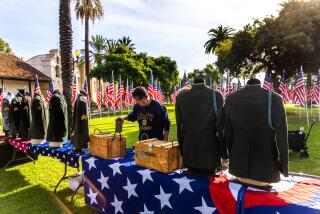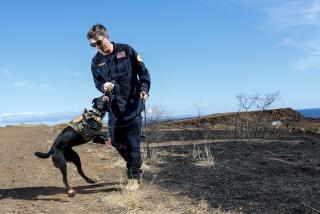The Dogs of War : Veteran of Guam Crusade Fights for Fitting Memorial to Heroic Canines
- Share via
WOODLAND HILLS — With a weathered thumb, William Putney traced on a map the route his Marines took through Guam during World War II and paused, tapping the spot where 25 members of his special forces lie buried in a remote jungle.
“That’s no place for war heroes,” Putney said. “They deserve better.”
These fallen troops were the dogs of war: Doberman pinschers and German shepherds that sniffed out mines, carried messages, scouted trails and guarded camp during the gritty liberation of Guam in 1944.
Half a century later, their 73-year-old commander and medic has not forgotten them.
From his comfortable home overlooking a golf course in Woodland Hills, Putney wages a lonely campaign to erect a memorial to the dogs that fought alongside their human comrades. It’s part hobby for the former Marine Corps captain, part obsession.
On a recent afternoon Putney leaned over his dining table, fingering yellowed photos of war dogs in light of the window. Outside, golfers in pastel shirts strolled silently toward the green, unnoticed as Putney relived muddy battles and the death of each of his dogs.
Missy, a German shepherd, was one of the division’s top messengers: smart, graceful and calm under fire. Putney shows a videotape of her swimming across a river to visitors who need to understand why dogs were used in war.
Then he curses her handler. Perhaps the young Marine wasn’t thinking straight. After two weeks hunting their scattered enemy, he and the patrol of a dozen men were tired. Missy’s handler decided to let her run ahead as a scout, something for which she wasn’t properly trained.
“When I found out what happened,” Putney recalled, “I said things to that man I can’t repeat.”
The handler unclicked Missy from her leash and, instead of moving to the front of the patrol, she bolted toward headquarters, backtracking on her own scent, running fast and low with no message attached to her collar.
The next day, another patrol brought Missy’s body back to Putney, who pulled seven slugs from her corpse.
A Doberman named Kurt died of shrapnel wounds the second day of the invasion. There had been a break in the morning rainfall, and the dog zigzagged in front of 250 Marines climbing the hill above the Asan Point beachhead, searching for the enemy.
It was a crucial moment for both sides, as the Americans tried to secure a foothold on the island.
Kurt froze, indicating troops in the bushes ahead of the Marines. The Japanese quickly bombarded the dog with hand grenades and shot his handler, who lived.
When Putney received Kurt at headquarters, the dog’s spine was exposed and several vertebrae were chipped, revealing the white spinal cord. Putney tried to save him by folding flesh over bone and stitching the skin back together. In the evening, Putney took the dog into his foxhole to watch the animal’s breathing.
“Kurt died late that night,” Putney said. “I was so tired I put my head on him and went to sleep.”
Bound by foxhole loyalties, the relationship between the Marines and dogs often transcended that of master and work animal. After the war, many handlers adopted their partners with the permission of the original owners. In all, 350 dogs served on Guam, some of them transferring to other islands in the Pacific theater.
The names of Missy, Kurt and 23 others are engraved on small headstones in an obscure clearing 20 miles inland. The dogs originally were buried at a national park at Asan Beach, but officials moved them in 1963 after a typhoon wrecked the canine cemetery.
Putney could not find his dogs when, five years ago, he returned to Guam for the first time since the war. Perturbed, he went to military and local officials, who gave him rough directions to the jungle graveyard.
After two days hacking his way along tangled footpaths, he came across a cluster of toppled headstones, almost missing them in the waist-high grass and vines.
“It was a disgrace,” he said with a Virginia drawl. “A disgrace and a dishonor.”
Putney returned to California and wrote letters to the governor of Guam, veterans officials, the National Park Service, canine-related organizations and old war buddies, trying to enlist support for a better resting place for his dogs. He had retired from his veterinary practice several years earlier, and his life suddenly had a new focus.
“He’s a bit obsessed,” said his wife, Betsy. “But it’s fun to be part of it.”
Putney followed the letters with phone calls and another visit to the island. In his absence, a U.S. Navy nurse had taken an interest in the forgotten graveyard, pruning back the jungle and straightening the headstones.
The nurse and Putney struck up a long-distance friendship and, until her recent transfer back to the Mainland, she kept the clearing manicured.
The war dog cemetery was recently added to a map of the island’s historical sites published by Guam’s Department of Parks and Recreation, and a Japanese tour group began to lead occasional treks there.
The buried dogs have also attracted more attention from locals, said Guam Gov. Joseph F. Ada, whose aunt lives near the cemetery.
“We always wondered why it was there when I was younger,” Ada said. “Now the contribution of the dogs has been brought up more clearly. I think people are grateful to them for their part in the liberation and the lives they saved.”
It is partly the sacrifice of canine for human life that makes Putney’s work so solemn. And history gives him an imperative.
*
Long before Shakespeare’s Antony said, “Cry havoc and let slip the dogs of war” in “Julius Caesar,” man was sending his best friend into battle.
The king of Persia unleashed them on the Egyptians in the 6th Century BC. The Romans used them to scare and attack enemy horses, as did Napoleon. Cortez and Hitler sent dogs out in front of their invading armies. Both North and South employed guard and messenger dogs in the Civil War.
But it is a part of history that is largely forgotten.
In Washington, D.C., a Vietnam veteran, Joe White, has tried in vain for several years to persuade the National Capital Memorial Commission to approve a war dog monument, undeterred by an act passed by Congress in 1986 to halt the spread of such memorials.
Putney, too, has had a hard time drumming up support from officials. His first proposal was to return the cemetery to the War in the Pacific National Historical Park at Asan Beach, where it would be accessible to the public and given regular care.
But after several years of review, the National Park Service sent a thumbs-down letter stating that the idea is “quite possibly against National Park guidelines and criteria.”
Undaunted, Putney said he may accept the Navy’s offer of a small plot of land for his planned memorial at its base at Orote Point, the Americans’ other beachhead in 1944. The logistics are set.
Volunteers from veterans groups on Guam have offered to move the headstones, and the United Doberman Club has agreed to pay for a life-size, bronze statue of a Doberman for the memorial. But it needs to happen soon.
Residents of Guam have invited the 55,000 U.S. troops that landed on the island and their families to a gala of parades and parties celebrating the 50th anniversary of the liberation of Guam on July 21. Putney wants the cemetery in plain view by then.
But if he misses that deadline, Putney has no intention of leaving his war dogs in the jungle.
“They’re going to have a place of honor before I crawl in my own hole,” he said. “That’s my promise to them.”
More to Read
Sign up for Essential California
The most important California stories and recommendations in your inbox every morning.
You may occasionally receive promotional content from the Los Angeles Times.













